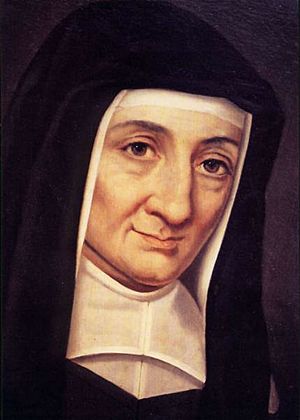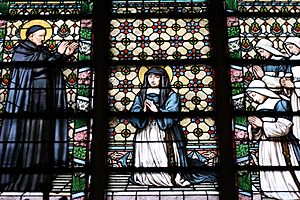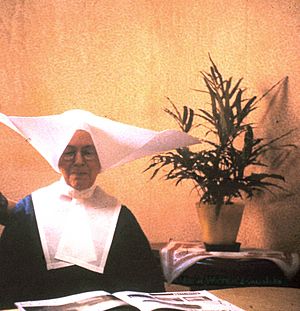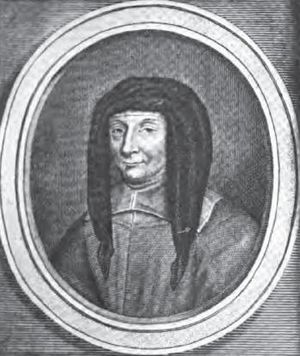Louise de Marillac facts for kids
Quick facts for kids SaintLouise de Marillac D.C. |
|
|---|---|
 |
|
| Wife, Mother, Widow, Foundress, Social Service Worker, Religious, Monastic, Workers of Charity | |
| Born | August 12, 1591 Le Meux, Oise, France |
| Died | March 15, 1660 (aged 68) Paris, France |
| Venerated in | Roman Catholic Church |
| Beatified | May 9, 1920, Vatican by Pope Benedict XV |
| Canonized | March 11, 1934, Vatican by Pope Pius XI |
| Major shrine | Chapel of Our Lady of the Miraculous Medal, Rue du Bac, Paris, France |
| Feast | May 4 |
| Attributes | Widow's clothing |
| Patronage | Christian Social Workers Disappointing children Loss of parents People rejected by religious orders Sick people Social workers Vincentian Service Corps Widows |
Louise de Marillac (born August 12, 1591 – died March 15, 1660) was an important French woman. She helped start the Daughters of Charity with Vincent de Paul. This group helped people who were poor and sick. Today, Louise is honored as a saint by the Catholic Church and the Episcopal Church.
Contents
Louise's Early Life
Louise de Marillac was born on August 12, 1591, near Le Meux, France. She never knew her mother. Her father, Louis de Marillac, was from a well-known family. He made sure Louise received a good education.
When Louise was young, she lived and worked among important French people. She went to a royal monastery in Poissy near Paris. Her aunt was a Dominican nun there. Louise learned a lot at the monastery.
After her father died when she was twelve, Louise lived with a kind woman. She learned how to manage a home and use herbal medicines. Around age fifteen, Louise wanted to become a nun. She tried to join a group of nuns in Paris but was not accepted. Her health was often poor. Her spiritual guide told her that God had "other plans" for her.
Marriage and Family Life
Louise was sad after being refused by the nuns. When she was 22, her family suggested she get married. She married Antoine Le Gras, who worked for Queen Marie. They were married on February 5, 1613.
In October, Louise and Antoine had their only child, a son named Michel. Louise loved her husband and was a caring mother. She also helped in her church. She was part of the Ladies of Charity. This group of wealthy women helped people who were poor and sick.
Challenges and Faith
Louise faced difficult times. Her two uncles, who were important in the government, were put in prison. One was executed, and the other died in prison. Around 1621, her husband Antoine became very ill. Louise took care of him and their son.
In 1623, Louise felt very sad and worried. She also felt guilty for not becoming a nun when she was younger. She found help from a wise priest, Francis de Sales. He and his friend, a bishop, guided her.
A Special Decision
In 1623, when she was 32, Louise had a special experience during church. She felt all her doubts disappear. She understood that she should stay with her husband for now. She also felt that later, she would be able to make promises to God. These promises would be about living simply, being pure, and obeying God. She believed she would do this in a small group with others.
Louise promised not to remarry if her husband died. She also felt she would meet a new spiritual guide. When she met Vincent de Paul, she recognized him from her vision.
Three years later, Antoine died. Louise was a strong and devoted woman. She created a plan for her daily life. It included time for prayer, church services, reading, and helping others. She also cared for her 13-year-old son, Michel, who needed extra support.
Working with Vincent de Paul
After Antoine died in 1625, Louise moved. Vincent de Paul lived nearby. At first, he was too busy to be her spiritual guide. He was busy with his "Confraternities of Charity." These groups of wealthy ladies helped the poor and neglected children. But Vincent needed more helpers, especially women who understood the lives of the poor. He also needed someone to teach and organize them.
For the next four years, Vincent and Louise met often and wrote letters. Vincent helped Louise find a calm and balanced way of life. In 1629, Vincent asked Louise to help with his charity groups. She was very good at this work. In 1632, Louise felt it was time to do even more to help the poor. She told Vincent de Paul about her goal.
Starting the Daughters of Charity
In the 1600s in France, helping the poor was not organized. The Ladies of Charity, started by Vincent, gave some help and money. But it was not enough. These wealthy women had money, but they often did not have time to live among the poor.
Vincent and Louise realized that direct help for the poor was hard for rich people. The wealthy women would visit slums in fancy dresses. This created a problem between wanting to serve and social rules. Also, their families often did not want them doing this work. It became clear that many of the ladies were not suited for the difficult conditions.
The wealthy ladies were better at raising money and writing letters. But the hands-on work, like nursing the poor in their homes and caring for children, was best done by women from similar backgrounds to those they served.
Vincent de Paul thought of forming a group of women in his church to help. It worked so well that it spread to Paris. There, noble ladies found it hard to give personal care. Many sent their servants, but the work was not always done well. Vincent solved this by sending young women who wanted to serve to Paris. They would work under the guidance of the Ladies of Charity. These young women became the first Daughters of Charity.
Louise found the help she needed in young, humble country women. They had the energy and the right attitude to help people who were very poor and suffering. She started working with some of them. She saw they needed to live together and be trained. So, she invited four country girls to live in her home. She began teaching them how to care for people in need.
The Daughters of Charity were different from other religious groups. Most nuns lived behind monastery walls and spent their time in prayer. But the Daughters of Charity went out to help people. "Love the poor and honor them as you would honor Christ Himself," Louise taught. This was the main idea of the Daughters of Charity. The group was officially approved in 1655. Their special uniform was a gray wool dress with a large white headdress. This was common clothing for peasant women in that time.
At first, the Daughters of Charity helped the sick and poor in their homes. Louise's work led to a system of care at the Hôtel-Dieu, the oldest hospital in Paris. Their work became famous. The Daughters were asked to go to Angers to manage the hospital's nursing services there. This was their first work outside Paris. Louise made the difficult trip with three nuns.
Louise worked with city officials and hospital managers. She created a team where doctors, nurses, and others worked together. This plan was very successful and is still used by the Daughters of Charity today. Under Louise's leadership, they expanded their work. They helped in orphanages, homes for the elderly and mentally ill, prisons, and even on battlefields.
Louise taught her sisters to live a balanced life, just as Vincent de Paul had taught her. She believed that combining prayer and action made their work successful. Near the end of her life, she wrote, "It is the great secret of the spiritual life to give everything we love to God by giving ourselves to all that He wants."
Louise led the Daughters of Charity until she died. Before her death, she wrote to her nuns: "Take good care of serving the poor. Most of all, live together in great unity and kindness, loving one another like Jesus."
Louise de Marillac died on March 15, 1660. She was 68 years old. The Daughters of Charity had more than 40 houses in France. They were well-respected and started groups all over the world.
Louise's Deep Faith
Louise had a very deep faith. She learned about prayer from her spiritual guides. She believed that Jesus becoming human was the most important moment for people's salvation.
Honoring Saint Louise
Louise de Marillac was declared "blessed" by Pope Benedict XV in 1920. On March 11, 1934, she was made a saint by Pope Pius XI. Her special day is May 9. Her body is in a chapel in Paris. It is a wax figure that holds her bones. In 1960, Pope John XXIII named her the Patroness of Christian Social Workers. The Episcopal Church also honors Louise de Marillac on March 15.
Places Named After Her
Many places are named after Saint Louise de Marillac, including:
- St. Louise de Marillac Parish in Pittsburgh, Pennsylvania.
- St. Louise de Marillac Parish in Bellevue, Washington.
- St. Louise de Marillac Parish and School in LaGrange Park, Illinois.
- St Louise's Comprehensive College in Belfast, Northern Ireland.
- St. Louise de Marillac Parish in Covina, California.
- St. Louise de Marillac Parish in Montreal, Quebec.
- St. Louise de Marillac Primary School in Ballyfermot, Dublin.
- Marillac Medical Clinic for the Poor in Grand Junction, Colorado.
- Parroquia Santa Luisa de Marillac in Santo Domingo, Republica Dominicana.
See also
 In Spanish: Luisa de Marillac para niños
In Spanish: Luisa de Marillac para niños





